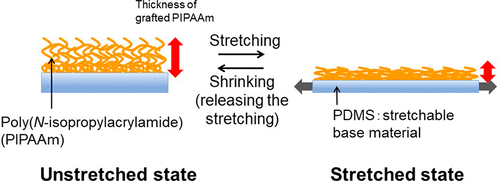当前位置:
X-MOL 学术
›
Biomacromolecules
›
论文详情
Our official English website, www.x-mol.net, welcomes your
feedback! (Note: you will need to create a separate account there.)
Poly(N-isopropylacrylamide)-Grafted Polydimethylsiloxane Substrate for Controlling Cell Adhesion and Detachment by Dual Stimulation of Temperature and Mechanical Stress
Biomacromolecules ( IF 5.5 ) Pub Date : 2018-09-05 00:00:00 , DOI: 10.1021/acs.biomac.8b00992 Yoshikatsu Akiyama 1 , Miki Matsuyama 1, 2 , Masayuki Yamato 1 , Naoya Takeda 2 , Teruo Okano 1
Biomacromolecules ( IF 5.5 ) Pub Date : 2018-09-05 00:00:00 , DOI: 10.1021/acs.biomac.8b00992 Yoshikatsu Akiyama 1 , Miki Matsuyama 1, 2 , Masayuki Yamato 1 , Naoya Takeda 2 , Teruo Okano 1
Affiliation

|
Stretchable temperature-responsive cell culture surfaces composed of poly(N-isopropylacrylamide) (PIPAAm) gel-grafted polydimethylsiloxane (PIPAAm-PDMS) were prepared to demonstrate that dual stimulation of temperature and mechanical stress extensively altered graft polymer thickness, surface wettability, and cell detachment behavior. The PIPAAm-PDMS surface was hydrophilic and hydrophobic below and above the lower critical solution temperature, respectively, which was ascribed to the phase transition of PIPAAm chains. When uniaxial stretching was applied, the grafted PIPAAm gel surface was modulated to be more hydrophobic as shown by an increase in the contact angle. Atomic force microscopy observation revealed that uniaxial stretching made the grafted gel layer thinner and deformed the nanoscale aggregates of the grafted PIPAAm gel, implying extension of the PIPAAm chains. The stretched PIPAAm-PDMS became more cell adhesive than the unstretched PIPAAm-PDMS at 37 °C. Furthermore, dual stimulation, shrinking the already stretched PIPAAm-PDMS and decreasing the temperature, induced more rapid cell detachment than only a change in temperature did. Similarly, upon comparison with a single stimulation of a change in temperature or mechanical stress, dual stimulation accelerated cell sheet detachment and harvesting. This new stretchable and temperature-responsive culture surface can easily adjust the surface property to a different cell adhesiveness by appropriately combining each stimulus and enable the fabrication of cell sheets of various species.
中文翻译:

聚(N-异丙基丙烯酰胺)接枝的聚二甲基硅氧烷基板通过温度和机械应力的双重刺激来控制细胞的粘附和分离
聚(N-异丙基丙烯酰胺(PIPAAm)凝胶接枝的聚二甲基硅氧烷(PIPAAm-PDMS)的制备表明,温度和机械应力的双重刺激极大地改变了接枝聚合物的厚度,表面润湿性和细胞脱离行为。PIPAAm-PDMS表面分别在较低的临界溶液温度以下和较高的温度下具有亲水性和疏水性,这归因于PIPAAm链的相变。当进行单轴拉伸时,接枝的PIPAAm凝胶表面被调节为更具疏水性,如接触角的增加所示。原子力显微镜观察显示,单轴拉伸使接枝的凝胶层更薄,并使接枝的PIPAAm凝胶的纳米级聚集体变形,这意味着PIPAAm链的延伸。在37°C时,拉伸的PIPAAm-PDMS比未拉伸的PIPAAm-PDMS具有更多的细胞粘附性。此外,双重刺激使已经伸展的PIPAAm-PDMS收缩并降低温度,比仅改变温度引起的细胞脱离更快。类似地,在与温度或机械应力变化的单次刺激相比较时,双重刺激加速了细胞片的分离和收获。通过适当地组合每种刺激,这种新的可拉伸且温度响应的培养表面可以轻松地将表面特性调节至不同的细胞粘附性,并能够制造各种物种的细胞片。诱导的细胞脱离比温度变化更快。类似地,在与温度或机械应力变化的单次刺激相比较时,双重刺激加速了细胞片的分离和收获。通过适当地组合每种刺激,这种新的可拉伸且温度响应的培养表面可以轻松地将表面特性调节至不同的细胞粘附性,并能够制造各种物种的细胞片。诱导的细胞脱离比温度变化更快。类似地,在与温度或机械应力变化的单次刺激相比较时,双重刺激加速了细胞片的分离和收获。通过适当地组合每种刺激,这种新的可拉伸且温度响应的培养表面可以轻松地将表面特性调节至不同的细胞粘附性,并能够制造各种物种的细胞片。
更新日期:2018-09-05
中文翻译:

聚(N-异丙基丙烯酰胺)接枝的聚二甲基硅氧烷基板通过温度和机械应力的双重刺激来控制细胞的粘附和分离
聚(N-异丙基丙烯酰胺(PIPAAm)凝胶接枝的聚二甲基硅氧烷(PIPAAm-PDMS)的制备表明,温度和机械应力的双重刺激极大地改变了接枝聚合物的厚度,表面润湿性和细胞脱离行为。PIPAAm-PDMS表面分别在较低的临界溶液温度以下和较高的温度下具有亲水性和疏水性,这归因于PIPAAm链的相变。当进行单轴拉伸时,接枝的PIPAAm凝胶表面被调节为更具疏水性,如接触角的增加所示。原子力显微镜观察显示,单轴拉伸使接枝的凝胶层更薄,并使接枝的PIPAAm凝胶的纳米级聚集体变形,这意味着PIPAAm链的延伸。在37°C时,拉伸的PIPAAm-PDMS比未拉伸的PIPAAm-PDMS具有更多的细胞粘附性。此外,双重刺激使已经伸展的PIPAAm-PDMS收缩并降低温度,比仅改变温度引起的细胞脱离更快。类似地,在与温度或机械应力变化的单次刺激相比较时,双重刺激加速了细胞片的分离和收获。通过适当地组合每种刺激,这种新的可拉伸且温度响应的培养表面可以轻松地将表面特性调节至不同的细胞粘附性,并能够制造各种物种的细胞片。诱导的细胞脱离比温度变化更快。类似地,在与温度或机械应力变化的单次刺激相比较时,双重刺激加速了细胞片的分离和收获。通过适当地组合每种刺激,这种新的可拉伸且温度响应的培养表面可以轻松地将表面特性调节至不同的细胞粘附性,并能够制造各种物种的细胞片。诱导的细胞脱离比温度变化更快。类似地,在与温度或机械应力变化的单次刺激相比较时,双重刺激加速了细胞片的分离和收获。通过适当地组合每种刺激,这种新的可拉伸且温度响应的培养表面可以轻松地将表面特性调节至不同的细胞粘附性,并能够制造各种物种的细胞片。









































 京公网安备 11010802027423号
京公网安备 11010802027423号